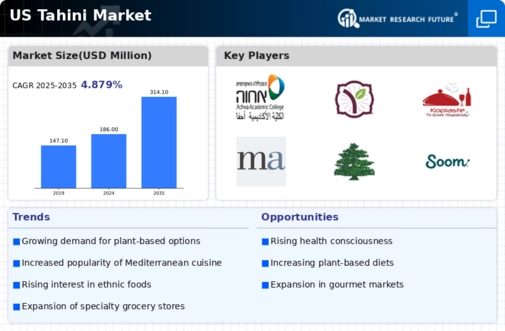The US Tahini Market has experienced a notable increase in demand, driven by the rising popularity of Mediterranean cuisine, health-conscious eating habits, and the growing trend of plant-based diets. As consumers increasingly seek out nutritious and versatile food options, tahini has secured a prominent place on grocery shelves and restaurant menus. This surge in interest has created a competitive landscape where established brands strive to differentiate themselves through innovative products, superior quality, and effective marketing strategies. Multiple players within the market are focusing on sustainable sourcing and emphasizing their products' natural attributes to attract a health-oriented consumer base.
As a result, the US Tahini Market has become a dynamic arena, characterized by both regional vendors and international brands competing for market share.Achva, a distinguished player within the US Tahini Market, stands out for its commitment to high-quality products and traditional manufacturing processes that respect the age-old methods of tahini production. With a strong brand reputation, Achva has successfully penetrated the US market, leveraging its authentic taste and superior texture to appeal to customers seeking premium options.
The company’s strengths lie in its ability to maintain consistency in product quality, invest in robust marketing strategies, and adapt to changing consumer preferences. This adaptability, combined with a customer-focused approach, has allowed Achva to cultivate a loyal consumer base. Its extensive distribution networks also ensure a substantial presence across various retail channels, further reinforcing its competitive position in the burgeoning tahini market.David and Sons has made a significant impact within the US Tahini Market through its range of quality products designed to meet diverse consumer needs.
The company offers a selection of tahini options, including organic and flavored varieties, appealing to health-conscious buyers and culinary enthusiasts alike. David and Sons’ strengths are further amplified by its commitment to quality sourcing and innovative product development, which keeps its offerings aligned with contemporary culinary trends. The brand's strategic presence in retail and online marketplaces allows it to reach a wide audience effectively. In addition to an expanding product line, David and Sons is actively exploring potential partnerships and acquisitions to enhance its market footprint and diversify its product offerings.
The company’s focused approach to expanding its distribution and continual improvement of product quality positions it well within the competitive landscape of the US Tahini Market.

















